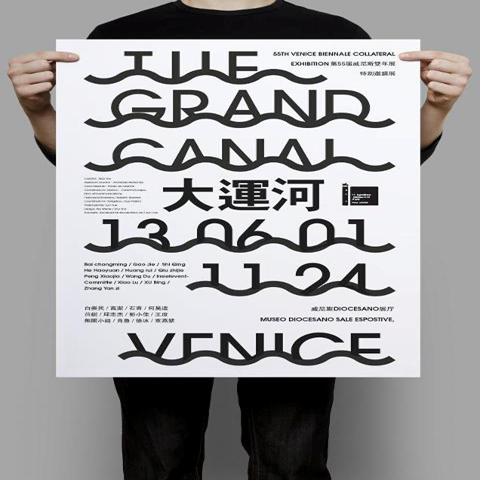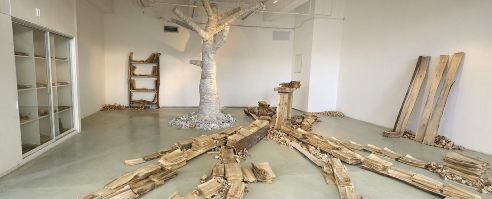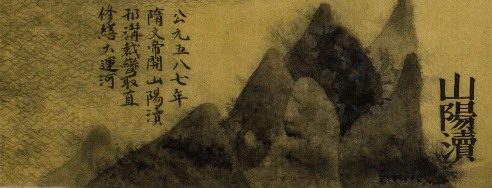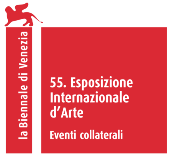
The Grand Canal
Collateral Event, 55th International Art Exhibition – La Biennale di Venezia
Curated by Xiao Ge
Artists: Bai Chongmin, Gao Jie, He Haoyuan, Huang Rui, Peng Xiaojia, Qiu Zhijie, Shi Qing, The Irrelevent Group, Wang Du, Xiao Lu, Xu Bing, Zhang Yanzi
June 1st – November 24th, 2013
Museo Diocesano, Sale espositive,
Castello 4312, 30122 Venezia
The Grand Canal and “Chinese New Sociology Art”
by Archibald McKenzie
In the 35 years since China embraced economic reform, Chinese intellectuals and artists have absorbed and internalized much of what the Western tradition had to offer as an alternative to the subservience of ideas and art to political needs and purposes outlined in 1942 by Mao Zedong in his Yan’an Talks and fully in force until the late 1970s. Key Western tradition elements of interest in the late 1970s and early 1980s were individualism and the Romantic-era notion of ‘art for the sake of art’. These ideas indeed played their part in liberating new Chinese art, but they ultimately run counter to the millennial mainstream tradition of Chinese intellectuals and artists, the wenren (‘scholars’), whose social conscience has been an aspect of the ruling orthodoxy in China since the Western Han Dynasty. Leading Chinese thinkers and artists have now processed the lessons of the West. Chinese art theory - and Chinese art - has absorbed the Western ideas that it has found to be of value and use, and is confidently moving on.
The artists in the “Grand Canal” exhibition do not form a homogenous group with collective ideas. Apart from their intrinsic quality and interest, they are linked only by direct and indirect connections to do with the great art academies in Beijing and Hangzhou. There are great differences of ideology and style among the artists. Nevertheless, the “Grand Canal” exhibition is representative of the paradigm shift away from Western values towards a fresh use of Chinese material, media and styles.
We have called this new direction “Chinese New Sociology Art” because there is a renewed engagement with real-world sociological, anthropological and environmental issues. It is “new” because the Western ideas on the standing of the individual have not previously been organically internalized within the Chinese tradition, and because it makes use of “new” media formats, but the development is not quite new, and may be traced back at least to 2003, when Qiu Zhijie began to teach at the Chinese Academy of Art and wanted “to introduce the methods of sociology and anthropology into the Art Academy” (Qiu, 2013). Indeed, as Shu Yang (Art Channel, 2009) points out, Chinese performance art has addressed social issues since the Reform and Opening Period (from 1978-9), although the focus of many of the early performance works was squarely on the individual human body, as a locus for social issues and perhaps to affirm the primary standing of the human body. The first Chinese formal exposition of contemporary art theory that seeks to harmonize Western and Chinese ideas is that of Gao Minglu (2009), but Professor Gao’s focus is not on phenomena of sociology and anthropology. The 2012 Shanghai Biennale, which was curated by Qiu Zhijie, may be the first large-scale official activity to embody this new sociological and anthropological direction.

The Grand Canal of China connects Beijing with Hangzhou. Beijing and Hangzhou are of course old Chinese cities, but have also been the cradles of new Chinese art in the twentieth century. This art was first inspired by styles including French Symbolism and nineteenth-century Russian Realism (more profoundly perhaps even than by Soviet Socialist Realism (Gao 2013), and then by European and American twentieth-century art movements from Abstraction to Postmodernism. The Grand Canal also connects the distant Chinese past with the future. The exact age of the oldest section of the Canal is forgotten (it is not less than 2500 years old), and the vast South-North Water Transfer project, which is not expected to be complete until about 2050, will largely be mapped onto the trajectory of the Grand Canal. At the same time, the Grand Canal connects crucial aspects of Chinese history, civilization and everyday life through its strategic, military, economic, commercial, agricultural and cultural use and importance. It thus offers rich sociological and anthropological material and themes, in keeping with the “Encyclopedic Palace” motto of the 55th Art Exhibition of La Biennale di Venezia. The Grand Canal theme also provides a number of symbolic dichotomies (in part by juxtaposition with the Great Wall and with the natural rivers of China, which almost all flow from west to east): natural /man-made, male/female, strategic/commercial, ideological/practical, vertical/horizontal… Yet it is not a “crazy dream” (Gioni), but a living compendium of economics, culture, and 2500 years of sociological, anthropological, military and political history. As such, it can also serve as a mirror for the world outside China.
Xiao Ge, the Curator of the Grand Canal exhibition is to be congratulated on her artistic judgment, international network and ability to bring together established personages of the Chinese art world as well as very worthwhile younger emerging artists. For this exhibition, she has indeed not only travelled the Grand Canal from Beijing to Yangzhou and Hangzhou, but also brought together Chinese artists working in Europe and America. The artworks in the Grand Canal exhibition bring together the best elements of the Chinese tradition with new sociological and anthropological directions in Chinese art and point to an international future where Chinese art and theory will not only stand confidently on their own distinctive foundations, but will also help inspire and stimulate new thinking on the relevance of art in the West.

Exhibition Artists
Performance artist, Bai Chongmin (b. 1970) has had solo exhibitions internationally at: Art Channel, Beijing; Declic Gallery, Luxembourge; The Orleans Governmental Art Center, France; The Governmental Art Center, Luxembourg; and Hanshi Gallery in Beijing. Bai has participated in performance art festivals including, International Performance Art Festival, Xi’an International Performance Art Festival, and Da Dao Live Art Festival.
Gao Jie (b. 1979) lives and works between Paris and Beijing. His solo exhibitions includes You are inside my head, A2Z ArtGallery (Paris), Life against life, Art Paris Art Fair 2011. His work was also included in The 9th Shanghai Biennale Special Exhibition- Zhongshan Park Project, Clermont-Ferrand International Video Art and New Media Festival and 20th Brest European Short Film Festival.
He Haoyuan (b. 1964) lives and works in Beijing and Israel. His work has been included in The 9th Shanghai Biennale Special Project-Zhongshan Park Project, Chinese contemporary Ceramic art U.S.A Invitational exhibition, Art Channel (Beijing), Duolun Museum of Modern Art (shanghai), and Shanghai Beiganshan International Art Center.
Huang Rui (b. 1952) is an artist based in Beijing. He is one of the founding members of the Chinese avant-garde art group the "Stars". Huang organized The Dashanzi International Art Festival, Reconstructing 798, and The Stars 1st and 2nd Exhibition in Beijing. He is also one of founders of the 798 Art District in Beijing. He has exhibited internationally with exhibitions in Philadelphia, Rome, Netherlands, France, Copenhagen, and New York.
Peng Xiaojia (b. 1955) has widely shown his work in the United States and China. Exhibitions include Beauty without animosity-Venus de Milo’s in 21st Century at Salvador Dali Museum (USA), Solo Exhibition of Xiaojia Peng—Sculptures at The International Sculpture Center (Washington D.C), Original Song Gallery of Shanghai, and The 9th Shanghai Biennale Special Project, Mingyuan• Zhongshan Park Project-On The Way Home, Shanghai Pudong International Airport Special Exhibition.
Curator of 9th Shanghai Biennial, Qiu Zhijie (b. 1969), is a professor at the School of Intermedia Art, China Academy of Art. His work has been widely exhibited at many museums and exhibitions including, Witte De With Contemporary Art Center (Rotterdam), Haus of World Culture (Berlin), Ullens Contemporary Art Center (Beijing), Chambers Fine Art (Beijing), 5th Shanghai Biennial (Shanghai), 6th Gwuangju Biennale (Korea), International Triennale of Contemporary Art (Yokohama), 25th San Polo Biennial (San Polo), and 53th Venice Biennal, Chinese Pavillion.
Shanghai and Beijing based artist, Shi Qing (b. 1969) has recently participated in international biennials and triennials including the 9th Shanghai Biennalle, SITE Santa Fe Seven International Biennial, The second Guangzhou Triennial, and the Prague International Biennale of Contemporary Art. His solo exhibitions include All That Is Solid Melts into Air at ShanghART H-Space (Shanghai), Halfway House at Shanghart Gallery (Beijing) and Black Taboo at 25000 Cultural Transmission Center (Beijing).
Irrelevant Committee was established in 2011, members included Chen Zhiyuan, Gao Fei, Guo Lijun, Jia Hongyu, Li Liangyong, Niu Ke, Wang Guilin, and Ye Nan. Selected exhibitions include Unrelated to Parading at Platform China, Beijing; Why Do We Do Useless Things at Tang Contemporary Art Center, Beijing; and We are Irrelevant Commission? at Miao Pu Art District, Beijing. The group has also shown at Ullens Center for Contemporary Art, Beijing and The 9th Shanghai Biennale, Shanghai.
Wang Du (b. 1956) moved to France in 1990 and lives and works in Paris. His solo exhibitions include Wang Du at Baltic, The Centre for Contemporary, Newcastle; Vancouver Art Gallery, Vancouver; The Time Tunnel at Palais de Tokyo, Paris and Disposable Consume Reality at Rodin Museum, Seoul. His works have also been included in exhibitions at the Dublin Contemporary 2011, Dublin; The Power of Art, Grand Palais, Paris; Be Biennale de Lyon, Lyon, France and 48th Venice Biennale, Italy.
Xu Bing (b. 1955) moved to the United States in 1990 and returned to China in 2007. His work has been widely exhibited at many museums and exhibitions, including the Metropolitan Museum of Art (New York), the British Museum (London), Museum of Modern Art (New York), Massachusetts Museum of Contemporary Art (MASS MoCA) and several Venice Biennales. Xu Bing was the recipient of a MacArthur Fellowship, Fukuoka Asian Culture Prize, and Wales International Visual Art Prize, Artes Mundi. In 2006, the Southern Graphics Council awarded Xu Bing their Lifetime Achievement Award. He was also awarded an Honorary Doctor of Humane Letters Degree by Columbia University in 2010.
Xiao Lu (b. 1962) first became famous for her gunshots at China/Avant-Garde Exhibition in Beijing, 1989. Xiao has showed internationally including shows at Pearl Lam Galleries (Hong Kong); Da Xiang Art Space (Taiwan); La Bellone (Brussels) and Stara Elektrarma (Republic of Slovenia).
Zhang Yanzi (b. 1967) received her MFA in Chinese Painting at China Central Academy of Fine Arts where she currently teaches. Zhang has showed internationally and her major exhibitions include The Cheju International Art Exhibition (Korea), Walk While Stepping on the Gauze-Solo Exhibition of Zhang Yanzi, Shanghai Art Museum and Airs of the States, Courtly Songs, and Hymns, 2nd Beijing International Art Biennale.
More information
Organizations: National Youth Center of the Chinese Central Government Organs; Chinese Academy of Cultural Heritage; China Grand Canal Application for Word Heritage List Office in Yangzhou; The West Lake Artists Association
Co-organization: People’s Government of Jiangdu District, Yangzhou City
In collaboration with: PDG Art Communication
Assistant Curator: Archibald Mckenzie
Commissioner: Paolo De Grandis
Coordinator in Venice: Carlotta Scarpa, PDG Art communications, Francesca Romane, Reberto Rosolen
Exhibition planner: Sun Yue, Wei Xingyi, Feng Jiao
Design: Wu Weihe, Zhu Sha
Translate: Archibald Mckenzie/Wen Zai, Sun Yue, Luca Zordan, Lv Meng
Press Contact: Zhu Xiaorui
T. +39.041.522 9166 T. +39.041.526 4546 F. +39.041.276 9056
thegrandcanalart@gmail.com
477653073@gmail.com
www.grandcanalart.org




